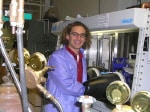Researchers in the US have made a solar cell from two types of inorganic nanocrystal. Unlike hybrid devices that contain both nanocrystals and a semiconducting polymer, the cell was stable in air. The cell, which was made by Ilan Gur and co-workers at the Lawrence Berkeley National Laboratory and the University of California at Berkeley, had a power-conversion efficiency of nearly 3% (Science 310 462).

The design is based on nanocrystals of cadmium selenide (CdSe) and cadmium telluride (CdTe). The materials were spin cast from a pyridine solution to form 100nm-thick layers on indium tin oxide glass coated with a 0.2nm-thick layer of alumina. The scientists put down a CdTe film first, annealed it to remove residual solvent and then added a CdSe film.
The idea is to combine the solution techniques used to make organic solar cells with the performance and robustness of devices based on inorganic semiconductors. Organic solar cells are attractive due to their potential low cost and ease of manufacture while inorganic devices have broadband absorption and superior charge transport. The researchers found that they could improve the properties of the devices by sintering the nanocrystals. They exposed the films to a solution of cadmium chloride in methanol and then annealed them at 400°C in air. This process increased the photoconductivity of the films by about two orders of magnitude. “We show that by sintering or fusing the nanocrystals together, we can produce cells with efficiencies approaching 3%,” said researcher Ilan Gur. “This is comparable to organic-based technologies, but these cells have the added advantage of being stable in air since they contain no organic components.”



